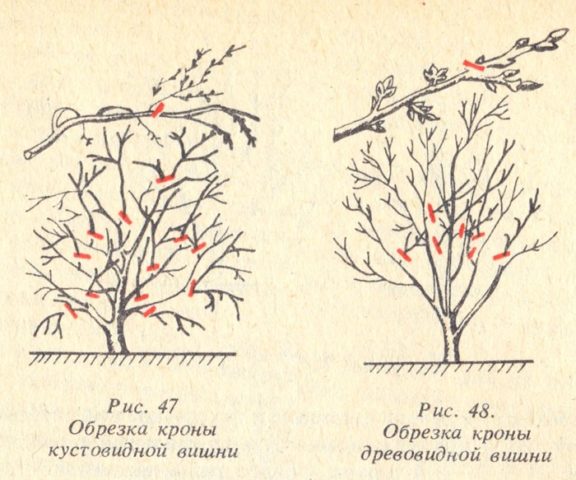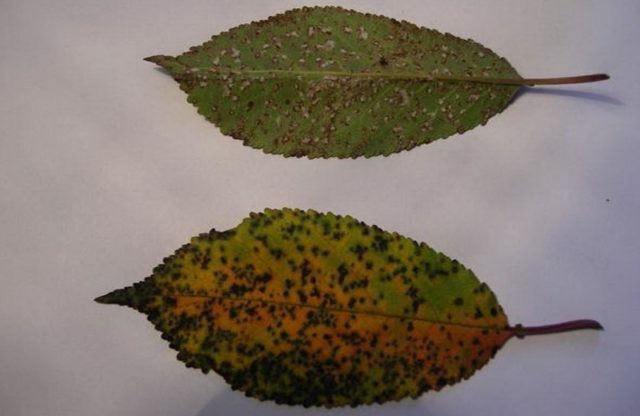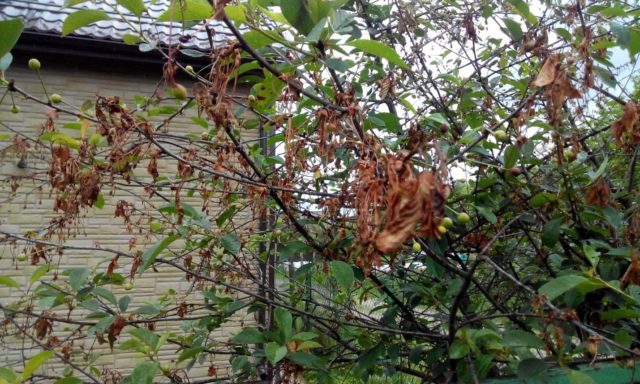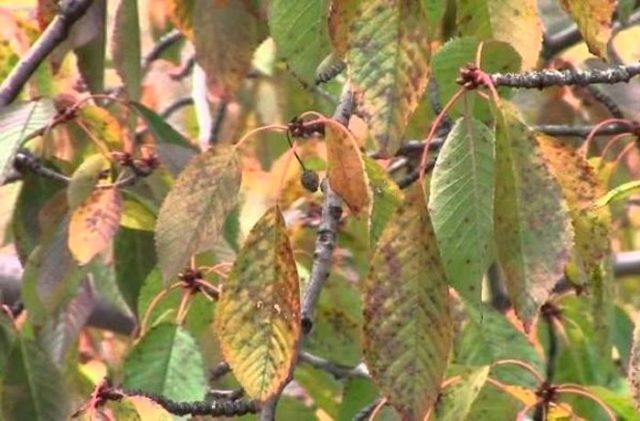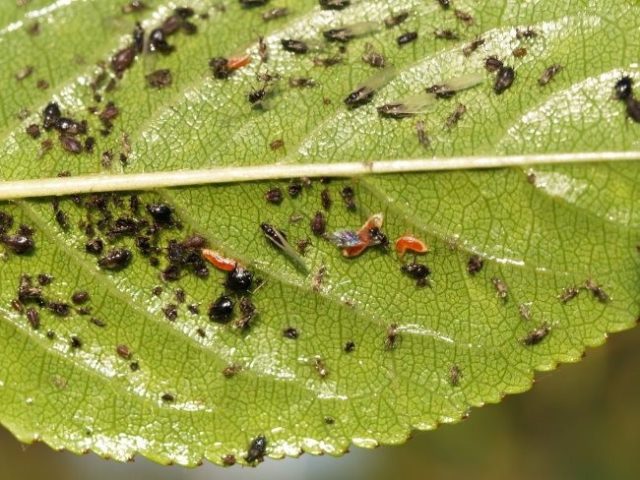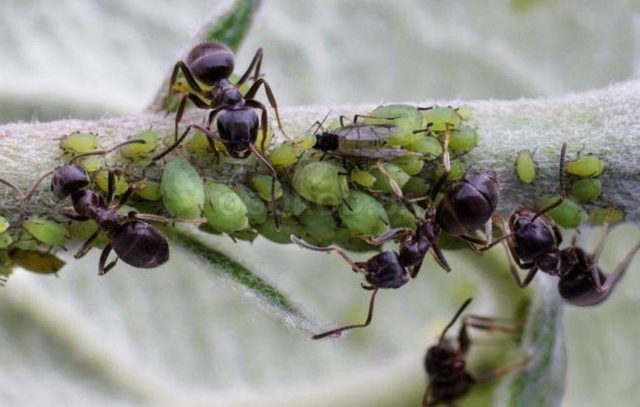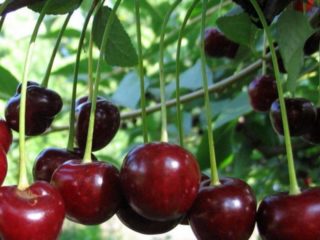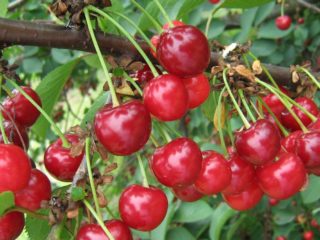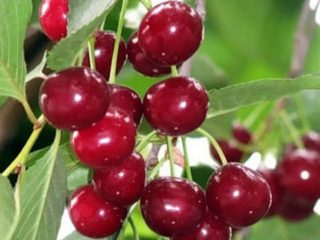Content
Among fruit trees and shrubs, varieties of the so-called folk selection always stand a little apart. History has not preserved information about their origin, but this does not prevent them from being popular and annually pleasing gardeners with a bountiful harvest. Among such crops there is also Apukhtinskaya cherry - a well-deserved and respected variety.
Description of Apukhtinskaya cherry
Next, a description of the Apukhtinskaya cherry will be presented, its photos are shown, pollinators are listed, gardeners' reviews on the cultivation of this variety are given. The material is for informational purposes only. More complete information about the Apukhtinskaya cherry can be found in the specialized literature.
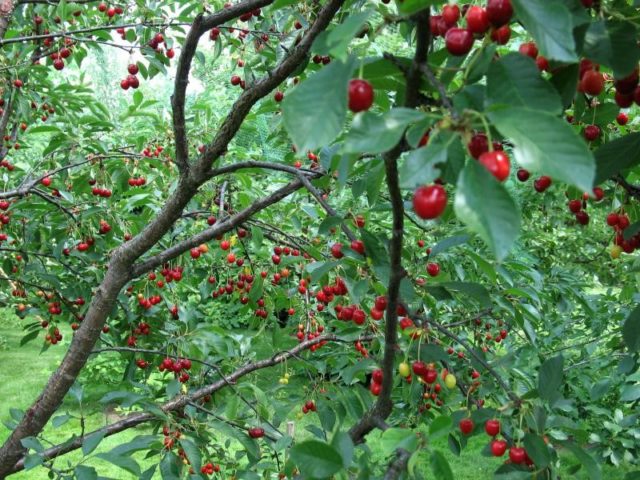
A variety of folk selection - Apukhtinskaya cherry
The homeland of Apukhtinskaya cherry is considered to be the Tula region, the village of Apukhtino. The parental forms of this cultivar are unknown. According to some reports, Apukhtinskaya cherry is related to Lotovoy Moreli, although this cannot be stated unequivocally. There is no information on this variety in the State Register. The plant is characterized by good winter hardiness and unpretentious care. It grows well in central Russia, and can be cultivated in more northern regions.
Cherry varieties Apukhtinskaya, photo and description of which are given in this article, in their appearance more resembles shrub varieties with well-developed skeletal shoots. The stem is short, well developed. The crown is drooping, sparse.
A short video review of this variety can be viewed at the link:
https://www.youtube.com/watch?v=7yN_6C6MA_A
Height and dimensions of an adult tree
An adult Apukhtinskaya cherry tree does not grow higher than 3 m. This is very convenient when working with it. The crown is round, its diameter is 2-2.5 m. The shoots are rather thin, bare as the tree ages.
Description of fruits
Apukhtinskaya cherries ripen rather late, in August. These are drupes weighing 3-3.5 g, dark red, rounded-flattened, with a wide central funnel. The skin of the fruit is thin, glossy. The pulp is juicy, ruby red, medium density. The taste is bright, sweet and sour, classic cherry. The stone is single, oval, rather large, easily separated from the pulp. The peduncle is long, thin, firmly attached to the fetus.
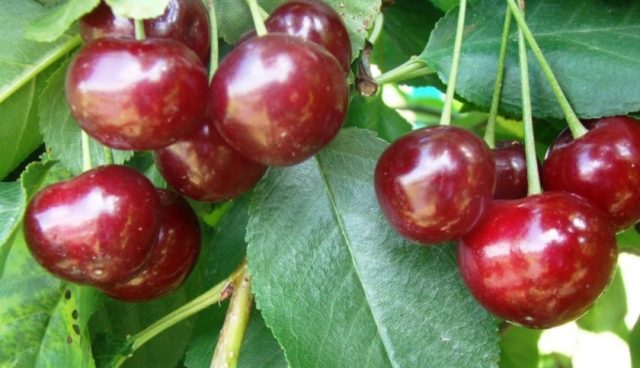
The berries of the Apukhtinskaya cherry are quite large
Semi-dry separation. The variety is not prone to shedding, since ripening occurs gradually. Due to the late ripening, berries are not baked in the sun either.
Cherry pollinators Apukhtinskaya
Cherry Apukhtinskaya is a self-fertile variety. Due to the peculiarities of the structure of the flower, pollination can occur even without opening. However, for maximum productivity, it is still desirable to plant pollinators nearby. Cherry Apukhtinskaya blooms quite late, in June, because of this, it is rather difficult to choose a pollinator variety for it according to the description. The vast majority of other varieties fade much earlier. As a pollinator for Apukhtinskaya cherry, Gorkovskaya, Zhuravka, Lotovaya, Lyubskaya, Malinovka, Schedrai can be suitable.
All these varieties bloom and ripen at about the same time as the Apukhtinskaya cherry, therefore they can be used for cross-pollination of each other.
Main characteristics
Cherry Apukhtinskaya has long been successfully grown in many regions of Russia. Such long-term popularity is associated with the resistance of this variety to various adverse factors, ease of maintenance and a stable annual yield.
Drought resistance, frost resistance
The winter hardiness of the Apukhtinskaya cherry is not very high, it is believed that it can safely tolerate temperature drops down to -20 ° C. This is a pretty average figure. In more severe frosts, shoots can freeze slightly, but in summer they quickly recover. Apukhtinskaya cherry also tolerates prolonged drought well. However, in the first two years, until the fruiting tree has fully formed, the soil should not be allowed to dry out.
Yield
Cherry Apukhtinskaya belongs to the early-growing varieties. After planting, the seedlings give the first harvest for 2 or 3 years, and after grafting - the next year after the procedure. The number of fruits increases annually, and by the age of 5, cherries are capable of producing up to 10 kg of berries. Fruiting of Apukhtinskaya cherry is annual and stable, with good care and favorable weather conditions, the harvest from 1 tree can reach 15-20 kg.
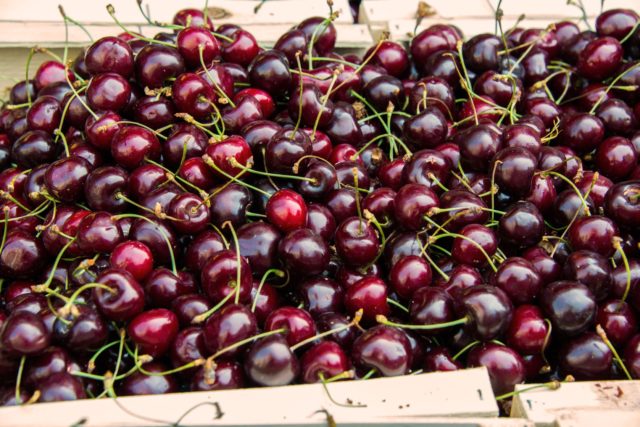
Under good conditions, the Apukhtinskaya cherry invariably pleases with the harvest
The purpose of the fruit is technical. Berries of Apukhtinskaya cherries are excellent for processing into preserves, jams, compotes. Fresh, they can also be consumed, however, the well-felt sourness, and sometimes bitterness in taste, is perceived by many negatively. It is advisable to start processing berries as soon as possible, since the keeping quality and transportability of Apukhtinskaya cherries is not very high.
Advantages and disadvantages
Experts and gardeners unanimously note the following advantages of Apukhtinskaya cherry:
- Early maturity.
- Annual fruiting.
- Late flowering, due to which the flowers are not damaged by recurrent frosts.
- Self-fertility.
- Resistance to major diseases.
- Inclination to shedding berries.
Cherry Apukhtinskaya is not without flaws. The main disadvantages of this variety are the following indicators:
- Mediocre taste of fruits and their technical purpose.
- Low keeping quality and transportability of berries.
- Exposure of trees to coccomycosis.
Despite the existing drawbacks, the Apukhtinskaya cherry variety remains popular among gardeners, and this is largely due to the plant's resistance to the vagaries of the weather and undemanding care.
Landing rules
The average lifespan of a cherry tree is 20 years. It is undesirable to transplant it to another place, therefore, before planting a seedling, you need to correctly assess the situation and choose a suitable place. High-quality planting material is of great importance. The Apukhtinskaya cherry seedling should have a healthy appearance, a good root with lateral branches, and there should be no mechanical damage on it.
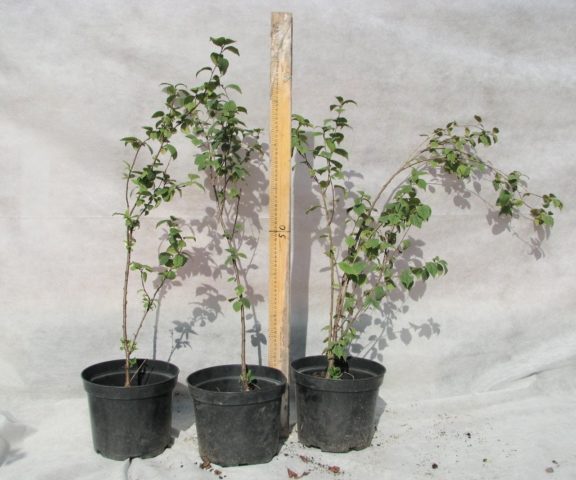
Cherry seedlings Apukhtinskaya are best purchased from ZKS
Recommended timing
Cherries enter the growing season very early, much earlier than many other fruit plants. It should be planted in early spring, as soon as the ground thaws. In areas with a warm climate, planting of Apukhtinskaya cherry can be postponed to autumn. It should be borne in mind that from the moment of planting to the onset of frost, at least 3 weeks must remain, so that the seedling is guaranteed to have time to take root in a new place.
Site selection and soil preparation
The best place for the Apukhtinskaya cherry is on the south side of the fence or a low building. At the same time, the seedling should not be in the shade of other buildings or tall trees, the lack of sun negatively affects the growth and yield of berries. Mail should be loamy or sandy loam, neutral or slightly alkaline.Groundwater at the landing site should lie at a depth of at least 2 m, if they are located higher, then you need to add soil.
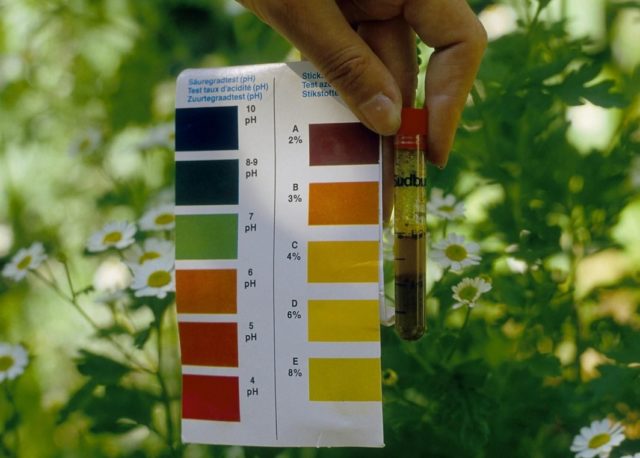
Normal soil acidity is the key to successful cherry cultivation
It is advisable to check the acidity level of the soil before planting. Too acidic soil must be neutralized by adding lime or dolomite flour. For the spring planting of Apukhtinskaya cherry, it is better to carry out all manipulations with the land in the fall, at the same time clearing the site of debris, stones and old vegetation. Before the autumn planting, it is better to prepare the site 2-3 weeks before the start of work.
How to plant correctly
Before planting Apukhtinskaya cherry seedlings, it is necessary to dig planting holes, the dimensions of which should be slightly larger than the volume of the root system. Practice shows that a depth of 0.6 m and a diameter of 0.6-0.8 m is quite enough. The extracted soil is mixed in equal proportion with humus, while adding a few tablespoons of superphosphate and 0.5 kg of wood ash to the nutrient soil. In the spring, it is advisable to add 1-2 tbsp to the above components. l. nitroammophoska or other nitrogen fertilizer, but with an autumn planting, it is better to do without it.
Before planting Apukhtinskaya cherry seedlings, a peg must be driven into the center of the pit, which will at first become a support for the future tree. If you do this after planting, then there is a great risk of damaging the roots of an already planted plant. Also, in the center of the pit, an earthen mound is poured, on the sides of which the roots of the seedling are spread. After that, the root system is gradually covered with nutritious soil. From time to time, it is advisable to add water and compact the soil, so you can reduce the likelihood of voids in the roots.

Planting cherries is always more convenient to carry out together.
After the planting hole is completely filled with soil, the seedling is tied to a support. A small earthen roller 8-10 cm high is poured around the stem so that the water does not spread, and then intensive watering of the root zone is carried out. Planting ends with mulching of the trunk circle with peat or humus, this will allow you to keep moisture in the soil longer.
Care features
Cherry Apukhtinskaya is quite undemanding to growing conditions, therefore, caring for it is not difficult. It includes only such mandatory procedures for gardeners as watering, feeding, various types of pruning, as well as periodic treatments for diseases and pests.
Watering and feeding schedule
The first 2 years after planting, watering of Apukhtinskaya cherries should be abundant and regular. In dry weather, young trees should be watered at least 1 time per week, pouring at least 10 liters of water under each specimen. It is better to do this in the late evening, so that evaporation from the soil surface under the influence of the sun is minimal. Adult fruiting cherries are less demanding for watering, however, they also need water, especially during the formation and pouring of berries. In dry weather, mature trees should be watered at least once a week, while the watering rate for each plant should be 20-30 liters.
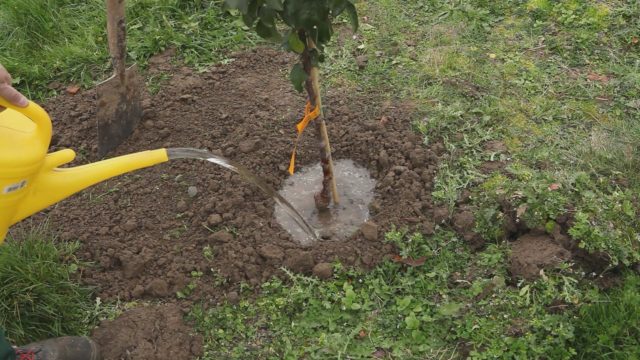
Cherries, especially at a young age, require regular watering
In the first 1-2 years after planting, there is no need to feed Apukhtinskaya cherries, since for this period there are enough fertilizers applied to the soil during planting for its development.With the onset of active fruiting, nutrients begin to be consumed much faster, and their lack in the soil must be replenished in a timely manner.

Organic application is an important part of cherry care work
Top dressing of Apukhtinskaya cherries is carried out in several stages.
- Early spring, before flowering. At this time, fertilizing is carried out with nitrogen fertilizers (urea, ammonium nitrate). For each tree, about 30 g is consumed. The fertilizer can be applied in dissolved form (usually they are diluted in 10 liters of water and watered with a solution of the root zone) or in dry, evenly scattering the granules over the surface of the earth. Many gardeners scatter dry dressings even over the last snow, in this case the nutrients go into the soil along with the melt water.
- At the end of the flowering period. The best feeding at this time is liquid organic matter - an infusion of chicken droppings or slurry. Such solutions are poured over the ground in the near-trunk circle.
- During the ripening of the fruit. During this period, foliar top dressing is performed by spraying trees with a urea solution (20 g of fertilizer per 10 liters of water).
- After fruiting. At this time, fertilizing is carried out with complex potassium-phosphorus fertilizers. You can also use organic matter, for example, humus or old rotted manure. Organic fertilizers are applied to the trunk circle when it is dug up in the fall.
Pruning
Cherry pruning helps to form a beautiful and practical tree crown, which is most convenient for the gardener and optimal for fruiting. In addition, some of the shoots are removed for preventive purposes.
Here are some types of pruning of Apukhtinskaya cherries:
- Formative... Produced to give the tree a specific shape. Depends on the preferences of the gardener and the climate.
- Sanitary... Held annually at the beginning and end of the season to clean the tree from old, diseased, broken and dry branches.
- Thinning... Produced to remove thickening crown, improperly growing shoots, as well as to clean the stem and root zone from unnecessary growth.
Preparing for winter
In the southern regions, Apukhtinskaya cherries are not sheltered for the winter. In more northern regions, young trees must be protected from frost. They are wrapped with a layer of breathable material, and also tied with spruce branches. Barrage nets are installed around the trunks, which will protect them from hares.
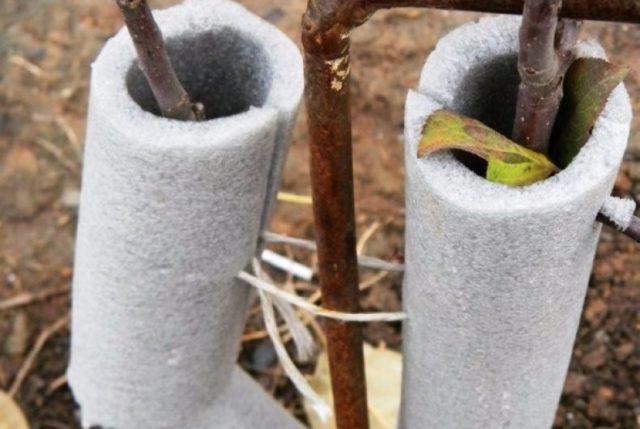
Cherry seedlings Apukhtinskaya for the winter must be covered
In mature trees, it is imperative to whitewash the stem and lower skeletal branches to a height of 1.5 m to protect against sunburn.
Diseases and pests
Cherry Apukhtinskaya has good immunity to diseases. Nevertheless, diseases can still appear, especially on weakened and aged specimens. Some of them are presented below.
Coccomycosis, Apukhtinskaya cherry has a tendency to this particular fungal disease. It can be recognized by its multiple reddish-brown small rounded specks that begin to cover the leaves of the tree in abundance.
As the disease progresses, the disease begins to affect not only the leaves, but also the fruits, which is why a significant part of the crop is lost. The disease greatly reduces the winter hardiness of cherries and can lead to their death in winter. Prevention is the timely cleaning of plant residues, sanitary pruning, as well as whitewashing the trunks and treating the tree with fungicides (Bordeaux liquid).
Moniliosis is a fungal disease, especially noticeable on a one-year growth. On diseased shoots, leaves begin to curl and turn brown, flowers or berries dry out. If you cut an infected branch, then you can find the presence of black rings on the cut.
Treatment and prevention of moniliosis consists in the timely treatment of cherries with fungicides, Fitosporin or Fitolavin preparations, as well as maintaining the purity of the bush and the trunk circle.
Scab, the disease usually manifests itself in regions with a warm climate. Leaves affected by scab curl up, turn yellow and dry, the fruits dry out or crack. The disease cannot destroy the tree, but its yield can suffer quite badly.
For the prevention and treatment of scab, cherries are treated with Bordeaux liquid several times during the season. Affected leaves and shoots should be trimmed and burned. The cherry trunk must be whitened, and the fallen leaves and affected shoots must be removed and burned in time.
No less dangerous for Apukhtinskaya cherries are various insect pests that spoil both the tree itself and the berry harvest. Here are some of them:
- Aphid Is a microscopic insect found in large numbers on many horticultural crops. Large colonies of aphids suck the sap from the leaves, which is very harmful to plants and young shoots. You can scare away aphids from cherries if you plant some types of plants next to trees: fennel, thyme, dill. The pest does not tolerate their pungent smell. To kill insects, trees are sprayed with various insecticides: Iskra, Inta-Vir. A good result is obtained by using an infusion of ash, garlic, celandine or tansy for this purpose.
- Ants. These insects appear on cherries together with aphids, which they themselves carry. Trapping belts, various mechanical obstacles, as well as special chemicals are used against ants.
Conclusion
Cherry Apukhtinskaya is a variety known and loved by many gardeners for a long time. Due to its unpretentiousness, it still remains popular, despite the emergence of new, more productive species. And this picture is unlikely to change. Popular varieties, such as the Apukhtinskaya cherry or the Antonovka apple tree, will always be in demand, since they are already a living history of Russia.
